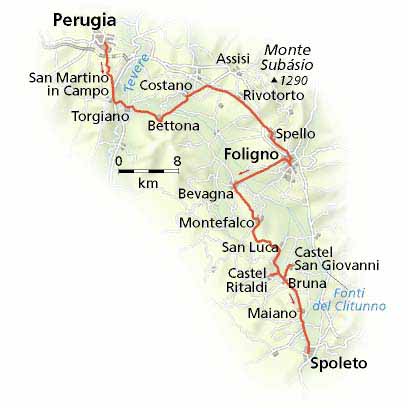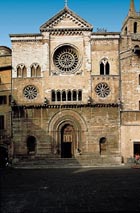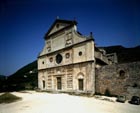DOC wines of south Perugia
 The tour starts in Torgiano, 15 kms from Perugia, goes on to Bevagna, climbs up to Montefalco and finishes at Spoleto. The route crosses some of the most attractive hills in Umbria, Italy’s green heartland, and leads the visitor to discover important historic centres surrounded by vineyards and three DOCG wines: Sagrantino, Sagrantino Passito and Torgiano Rosso Riserva. There are also three excellent DOC wines: Grechetto Colli Martani, Torgiano, and Rosso Colli Martani
The tour starts in Torgiano, 15 kms from Perugia, goes on to Bevagna, climbs up to Montefalco and finishes at Spoleto. The route crosses some of the most attractive hills in Umbria, Italy’s green heartland, and leads the visitor to discover important historic centres surrounded by vineyards and three DOCG wines: Sagrantino, Sagrantino Passito and Torgiano Rosso Riserva. There are also three excellent DOC wines: Grechetto Colli Martani, Torgiano, and Rosso Colli Martani

Torgiano
The crest of this medieval town contains a bunch of grapes to indicate that it is a wine-producing region. The excellent local DOC Torgiano wine has been known and appreciated for centuries since the time of the Benedictine monks. The original Torgiano white wine has now been joined by an intense, glowing red wine known as Rubesco. Visitors who wish to find out more can visit the Museo del Vino, which was opened by the Lungarotti vineyard in 1974 in the 18th-c. Palazzo Baglioni.
Bettona
This small scenic town at the meeting point of the Chiascio and Topino rivers holds a record: before becoming a Roman municipium it was the only Etruscan settlement on the left bank of the Tiber and the only sign that this fascinating civilisation ever expanded beyond its natural river boundary. Nowadays the attractive town is medieval in appearance but is still encircled by imposing Etruscan walls made out of stone blocks (dating from the 4th c. bc). You will see a rectangular Etruscan hypogeum (2nd c. bc) shortly before you reach the hilltop town.
Spello
 Thousands of years ago, the Romans founded an extremely fine city on the final slope of land that extends from Mount Subasio towards the plain. The Roman town was so well-sited on the trade routes to Perugia that it was never abandoned, even during the Middle Ages. Spello is now therefore the most ‘Roman’ of Umbria’s medieval towns, with its Roman walls and gates (Venere, Urbica and Consolare, 1st c. bc) and its well-endowed archaeological area. For centuries the town was also an active medieval spiritual centre full of churches and extraordinary buildings. These include Santa Maria Maggiore (11th–13th c.), which contains the splendid Cappella Baglioni with frescos by Pinturicchio painted in 1501. San Andrea, originally a Romanesque church, contains another work by Pinturicchio, i.e. a panel depicting a Madonna with Child and Saints. Lastly, the lay Palazzo Comunale building was built in 1270 and features a big open gallery with Gothic arches.
Thousands of years ago, the Romans founded an extremely fine city on the final slope of land that extends from Mount Subasio towards the plain. The Roman town was so well-sited on the trade routes to Perugia that it was never abandoned, even during the Middle Ages. Spello is now therefore the most ‘Roman’ of Umbria’s medieval towns, with its Roman walls and gates (Venere, Urbica and Consolare, 1st c. bc) and its well-endowed archaeological area. For centuries the town was also an active medieval spiritual centre full of churches and extraordinary buildings. These include Santa Maria Maggiore (11th–13th c.), which contains the splendid Cappella Baglioni with frescos by Pinturicchio painted in 1501. San Andrea, originally a Romanesque church, contains another work by Pinturicchio, i.e. a panel depicting a Madonna with Child and Saints. Lastly, the lay Palazzo Comunale building was built in 1270 and features a big open gallery with Gothic arches.
Foligno
 This has been a town of industry and trade since Roman times due to its strategic position between two branches of the Via Flaminia and the Topino river. Foligno was founded by the Romans and knew great splendour during the Middle Ages, when it was surrounded by walls. During the 18th c., the town also gained fine new classical churches and palaces such as the Chiesa dell’Annunziata (1760). Medieval Foligno is full of charm: the Romanesque facade of the duomo dates back to 1133, while the interior was designed by two masters of the Italian Baroque, L. Vanvitelli and G. Piermarini. The interior of Palazzo Trinci (14th c.), now an art gallery, offers its own fresh interpretation of international Gothic decorative motifs. Lastly, the church of Santa Maria Infraportas (11th–12th c.) preserves its original Romanesque structure almost intact. Every year the ancient Giostra della Quintana tournament is played out in the centre of Foligno by the town’s inhabitants.
This has been a town of industry and trade since Roman times due to its strategic position between two branches of the Via Flaminia and the Topino river. Foligno was founded by the Romans and knew great splendour during the Middle Ages, when it was surrounded by walls. During the 18th c., the town also gained fine new classical churches and palaces such as the Chiesa dell’Annunziata (1760). Medieval Foligno is full of charm: the Romanesque facade of the duomo dates back to 1133, while the interior was designed by two masters of the Italian Baroque, L. Vanvitelli and G. Piermarini. The interior of Palazzo Trinci (14th c.), now an art gallery, offers its own fresh interpretation of international Gothic decorative motifs. Lastly, the church of Santa Maria Infraportas (11th–12th c.) preserves its original Romanesque structure almost intact. Every year the ancient Giostra della Quintana tournament is played out in the centre of Foligno by the town’s inhabitants.
Bevagna
 This town is situated slightly away from the usual Umbra valley tourist haunts along the ancient Via Flaminia on the Foligno plain. It enjoyed great and stable prosperity during Roman times and the Middle Ages. The long years of historical and artistic wealth have left their mark on the settlement. The streets are laid out in a rectangular pattern and the medieval town fits perfectly over the Roman remains. An encircling wall built between 1249 and 1377 is opened by gates, of which Porta Foligno is a fine example. The town also contains large medieval squares (Piazza Silvestri and Piazza Garibaldi).
This town is situated slightly away from the usual Umbra valley tourist haunts along the ancient Via Flaminia on the Foligno plain. It enjoyed great and stable prosperity during Roman times and the Middle Ages. The long years of historical and artistic wealth have left their mark on the settlement. The streets are laid out in a rectangular pattern and the medieval town fits perfectly over the Roman remains. An encircling wall built between 1249 and 1377 is opened by gates, of which Porta Foligno is a fine example. The town also contains large medieval squares (Piazza Silvestri and Piazza Garibaldi).
Montefalco
If you stand in the great central square of this hilltop town you can let your gaze wander over one of the most beautiful views in all Umbria: a mosaic of olive groves, ploughed fields, vineyards and meadows. The whole area is criss-crossed by thousands of country tracks and Bevagna and Foligno can be seen in the background. The medieval town of Montefalco came into its own artistically at the time of the Franciscans. The town’s art gallery is housed in the very fine former church of San Francesco, which contains frescoes by Benozzo Gozzoli dating back to the 15th c.
Spoleto
 This historical town is probably the most international centre in the region. Every summer, the town’s paved squares and austere light-stoned buildings provide the setting for the prestigious Festival dei Due Mondi (Two World Festival), the musical and theatrical event that brings together the best performers from Europe and America. From a distance, Spoleto looks compact and solemn. The town has grown up on a hill amid the slopes of Monteluco on a site chosen by the Umbrians and Romans for its strategic position dominating the plain. Spoleto is steeped in history. To begin with, the town was obviously prosperous during medieval times when it was an active monastic centre due first to the Benedictines and then to the Franciscans and the Dominicans. Later, between the 17th and 18th c., it benefited from the wealth of the newly-rich aristocracy. Every possible architectural and artistic space has been filled harmoniously to give the city a pleasingly varied appearance.
This historical town is probably the most international centre in the region. Every summer, the town’s paved squares and austere light-stoned buildings provide the setting for the prestigious Festival dei Due Mondi (Two World Festival), the musical and theatrical event that brings together the best performers from Europe and America. From a distance, Spoleto looks compact and solemn. The town has grown up on a hill amid the slopes of Monteluco on a site chosen by the Umbrians and Romans for its strategic position dominating the plain. Spoleto is steeped in history. To begin with, the town was obviously prosperous during medieval times when it was an active monastic centre due first to the Benedictines and then to the Franciscans and the Dominicans. Later, between the 17th and 18th c., it benefited from the wealth of the newly-rich aristocracy. Every possible architectural and artistic space has been filled harmoniously to give the city a pleasingly varied appearance.
|
THE PLEASURES OF THE TABLE |
|
| Pecorino umbro | Olio affiorato |
| Made throughout the Umbrian Apennines, especially in Norcia, Cascia, Spoleto, Gualdo Tadino and Gubbio. Made in 3kg whole cheeses from sheep’s milk taken from the Sopravissana breed. Sweet and easy to eat when fresh, tasty with a good bite to it after maturation. Eaten by itself when young and used as a grating cheese when matured, especially with pasta dressed with mutton ragù sauce | Umbria is famous for the quality of its olive oil generally, but the olio affiorato (literally “skimmed” olive oil) made exclusively by Alfredo Mancianti at his San Feliciano olive oil mill on Lake Trasimene is something particularly special, and only available in the best delicatessens. In essence it consists of the skin of oil that comes to the top of the each pressed mass of olives in the mill. Skimmed off by hand with a special flat paddle it is left to settle in centuries-old earthenware jars and bottled after just a month. |
| Lenticchie di Castelluccio | Tartufo nero di Norcia |
| Don’t miss the famous Castelluccio lentils while you are in Umbria. They grow at 1300 metres altitude above sea level at the foot of the Sybilline mountains and are the fruit of the eponymous plant. They are tiny, no more than 2mm in diameter and have a delicate flavour and long keeping qualities. The crop is grown in rotation with wheat and hay and production has always been organic. Total production quantities are very small and there are three types: green, red, and mottled. Principally used in soups, risottos, vegetable stews, salads, and braised or stewed meat dishes. | Among the many types of truffle found in Umbrian, including the white truffle and the scorzone (literally “rough”) truffle, the most famous and most important one is the black truffle of Norcia and Spoleto, exactly equivalent to the black Périgord truffle. Found principally in dry, chalky pebbly land between 250 and 900 metres above sea level. Wrinkled blackish skin, with black and violet tinged texture inside, mottled with white veins. Refined and delicate perfume. Always eaten as part of another dish, with sauces on local pasta, or used to flavour terrines and soufflés. |
|
THE WINE |
| At the center of the region lies the zone of Perugia, the most important in terms of wine production. Here grows the origin of the two Umbrian D.O.C.G. wines, the Torgiano Rosso Riserva and the Sagrantino di Montefalco, both taking their name from their village of origin. The first is obtained from the San Giovese grape in a tiny, extremely hilly zone that benefits from a climate that particularly favors the concentration of sugar in the grape. It is a deep ruby color with a delicate vinous bouquet. The second wine is grown from an autoctono Sagrantino vine of extremely ancient origins, probably imported from Spain. It has a characteristic bouquet that hints of blackberry and an intense ruby color that borders on cranberry. If you would like to prepare a lunch or dinner reminiscent of the area, click here to purchase wines carefully selected by our experts. |
|
EATING AND SLEEPING |
| The winery in Piazza Onofri in Bevagna (tel. +39 0742-361926) deserves a stop. It has excellent local cuisine offered by the Santificetur family, such as cold cuts and cheeses from Umbria, vegetable soup, grilled and roasted beef or pork, lasagne pasta and strangozzi, as well as wild game when in season and a wide range of wines from the region. In Foligno, we recommend the Bacco Felice (tel. +39 742-341019) a small restaurant in the historical centre destined as a winery. Besides its rich wine list, the Bacco Felice proposes traditional regional dishes with special care to the vegetables, which are rigorously organic. A great place to spend the night in Foligno is the Villa Roncalli (tel. +39 0742-391091) an hotel restaurant in a small villa immersed in a beautiful garden, spacious rooms and an excellent service. A good address to keep in mind when in Spoleto is the Gattapone (tel. +39 0743-223447), a small hotel that gets its name from the architect who designed the Torri Bridge in the 1300s, which can be admired from the rooms. It has an excellent service and it is located in a peaceful surrounding. |








